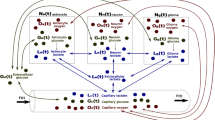Abstract
We provide a mathematical study of a model of energy metabolism and hemodynamics of glioma allowing a better understanding of metabolic modifications leading to anaplastic transformation from low grade glioma.This mathematical analysis allows ultimately to unveil the solution to a viability problem which seems quite pertinent for applications to medecine.


Similar content being viewed by others
References
Aubert A, Costalat R (2005) Interaction between astrocytes and neurons studied using a mathematical model of compartmentalized energy metabolism. J Cereb Blood Flow Metab 25:1476–1490
Aubert A, Costalat C, Magistretti PJ, Pellerin L (2005) Brain lactate kinetics: modeling evidence for neuronal lactate uptake upon activation. Proc Natl Acad Sci USA 102:16448–16453
Gjedde A (1997) The relation between brain function and cerebral blood flow and metabolism. In: Batjer HH (ed) Cerebrovascular Disease. Lippincott-Raven, Philadelphia, pp 23–40
Guillevin R et al (2008) Proton magnetic resonance spectroscopy predicts proliferative activity in diffuse low-grade gliomas. J Neurooncol 87:181–187
Guillevin R et al (2011) Mathematical modeling of energy metabolism and hemodynamics of WHO grade II gliomas using in vivo MR data. CR Biologies 334:31–38
Keener J, Sneyd J (1998) Mathematical physiology. Springer, New-York
Law M et al (2006) Perfusion magnetic resonance imaging predicts patient outcome as an adjunct to histopathology: a second reference standard in the surgical and nonsurgical treatment of low-grade gliomas. Neurosurgery 58:1099–1107
Mathupala SP, Parajuli P, Sloan AE (2004) Silencing of monocarboxylate transporters via small interfering ribonucleic acid inhibits glycolysis and induces cell death in malignant glioma: an in vitro study. Neurosurgery 55:1410–1419
Pellerin L, Magistretti PJ (1994) Glutamate uptake into astrocytes stimulates aerobic glycolysis: a mechanism coupling neuronal activity to glucose utilization. Proc Natl Acad Sci USA 91:10625–10629
Thomas SR et al (2008) SAPHIR: a physiome core model of body fluid homeostasis and blood pressure regulation. Philos Trans A Math Phys Eng Sci 366:3175–3197
Valabrègue R et al (2003) Relation between cerebral blood flow and metabolism explained by a model of oxygen exchange. J Cereb Blood Flow Metab 23:536–545
Acknowledgments
Partially supported by an ANR grant “Analyse non linéaire et applications aux rythmes du vivant” BLAN07-2-182920.
Author information
Authors and Affiliations
Corresponding author
Additional information
Partially supported by an ANR grant “Analyse non linéaire et applications aux rythmes du vivant” BLAN07-2-182920.
Rights and permissions
About this article
Cite this article
Costalat, R., Francoise, JP., Menuel, C. et al. Mathematical Modeling of Metabolism and Hemodynamics. Acta Biotheor 60, 99–107 (2012). https://doi.org/10.1007/s10441-012-9157-1
Received:
Accepted:
Published:
Issue Date:
DOI: https://doi.org/10.1007/s10441-012-9157-1
Keywords
- Magnetic resonance spectroscopy
- Multinuclear spectroscopy
- Regional cerebral blood flow
- Differential equation
- Viability
- Slow-fast dynamics




